Within these six tetrahedron zones form gyroscopic cones (vortices) along three primary depolar magnetic lines of the three dimensions normal to the three Planes of Neutrality. See Figure 3.22, Figure 4.6 - Triple Vectors in Motion on Triple Planes, Figure 4.11 - Six Planes and Three Shafts Coincide to Produce Spheres, Figure 7B.15 - Triple Planes relative to Center and elsewhere.
Russell
"The one thing which is almost impossible for the mind of man to comprehend is to look into that blank dark nothingness of such a diagram as Figure 59, and Figure 63 in a lesser degree, and realize that they are on three-dimensional angles of ninety degrees from their axes of rotation, like the eight other cubes and six tetrahedrons which govern that division by dividing the indivisible "nothingness" into divided pairs of spectrum lights for the purpose of again uniting them into the oneness from which they sprang.
It will help to vision this opposition of direction by throwing a stone into the water. Even though the centripetal spiral which surrounds the falling stone is parallel to the ripples caused by it, the direction of the force of its falling is ninety degrees from the direction in which it falls.
If these diagrams and the others throughout these lessons help to visualize the universe and the Creator of it into sufficient reality to help mankind to be transformed into Cosmic Knowers instead of sensed thinkers, our combined efforts in writing these lessons will have been well repaid. It is in this spirit that we will feel fully repaid and rejoice with you because of it." [Home Study Course, Unit 11, Lesson 43, pages 817-821]
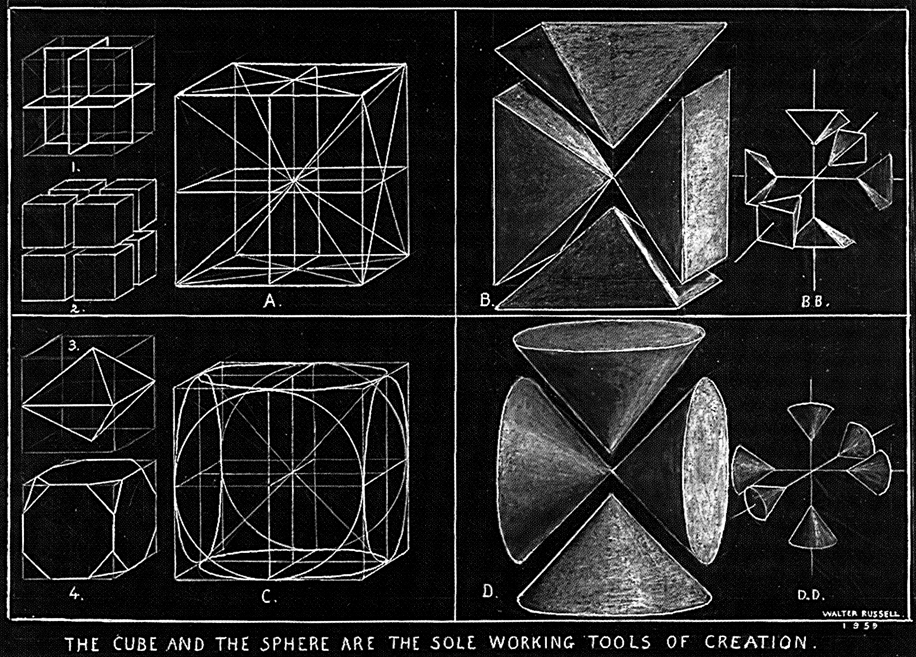
Figure 6.6 - Russell's Multiple Views of Tripleness
See 6.6 - Cube Corner Retroreflectors
(courtesy of University of Science and Philosophy)

Figure 6.7 - Perspective of Tetrahedral Apices at Concentrative Centers (courtesy of University of Science and Philosophy) (click to enlarge)
Figure 6.8 - Resulting in a Cube mutually assimilating to a Common Center from Six Directions (along Three Axis) as also see Square Law
(courtesy of University of Science and Philosophy)
(click to enlarge)
The Octave being divided into 53 commas, the intervals are measured, as usual, by these, the large second having 9-commas, the medium second having 8, and the small second 5. These measures are then made each the radius by which to draw hemispheres showing the various and comparative areas of the seconds. The comparative areas of the thirds are shown by the hemispheres of the seconds which compose them facing each other in pairs. The comma-measures of the various thirds thus determined are then made the radii by which to draw the two hemispheres of the fifths. The areas of the three fifths are identical, as also the attitudes of their unequal hemispheres. The attitude of the six thirds, on the other hand, in their two kinds, being reversed in the upper and under halves of the scale, their attitude gives them the appearance of being attracted towards the center of the tonic; while the attitude of the three fifths is all upward in the major, and all downward in the minor; their attraction being towards the common centerof the twelve scales which Nature has placed between the second of the major and the fourth of the minor, as seen in the two D's of the dual genetic scale, - the two modes being thus seen, as it were, revolving [Scientific Basis and Build of Music, page 113]
round a common center which is lying between them, as the double stars do in the astral heavens. When this plate is reversed we have before us exactly the minor scale, and all the parts and attitudes related in exactly the inverse way, each to each, so perfect is the duality in unity of the two modes. [Scientific Basis and Build of Music, page 114]
See Also
Think of these sides as compressing into the center generating power, heat, density and light. This self-assimilating compaction (syntropy) by mutual approximation will be covered in more detail in other sections. These cubes are as the Square Law and Inverse Square Law.
|
|
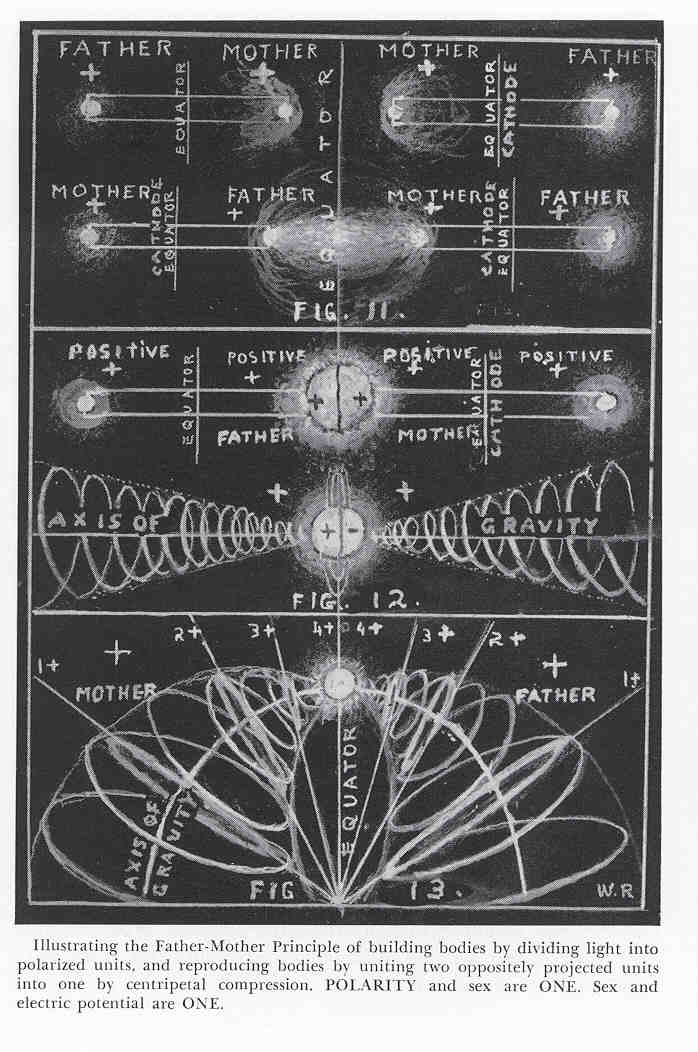
|
Figure 6.9a - Structure of Cubes of Motion Figure 6.9b - Wave dynamics between Cube Corners Russell depicts his waves in two ways. (courtesy of University of Science and Philosophy)
Showing the 0 potential shown at the crest of the wave as shown above left (in the lower right image) and as 4++ shown as the crest above right, lowest image. Either way is accurate and reveals the inner workings of the dynamical wave phenomena. Upper left also shows 0 at center of Cube. Lower left shows 0 at periphery of virtual Cube. Wave means the dynamical motions of concentration and dissociation.
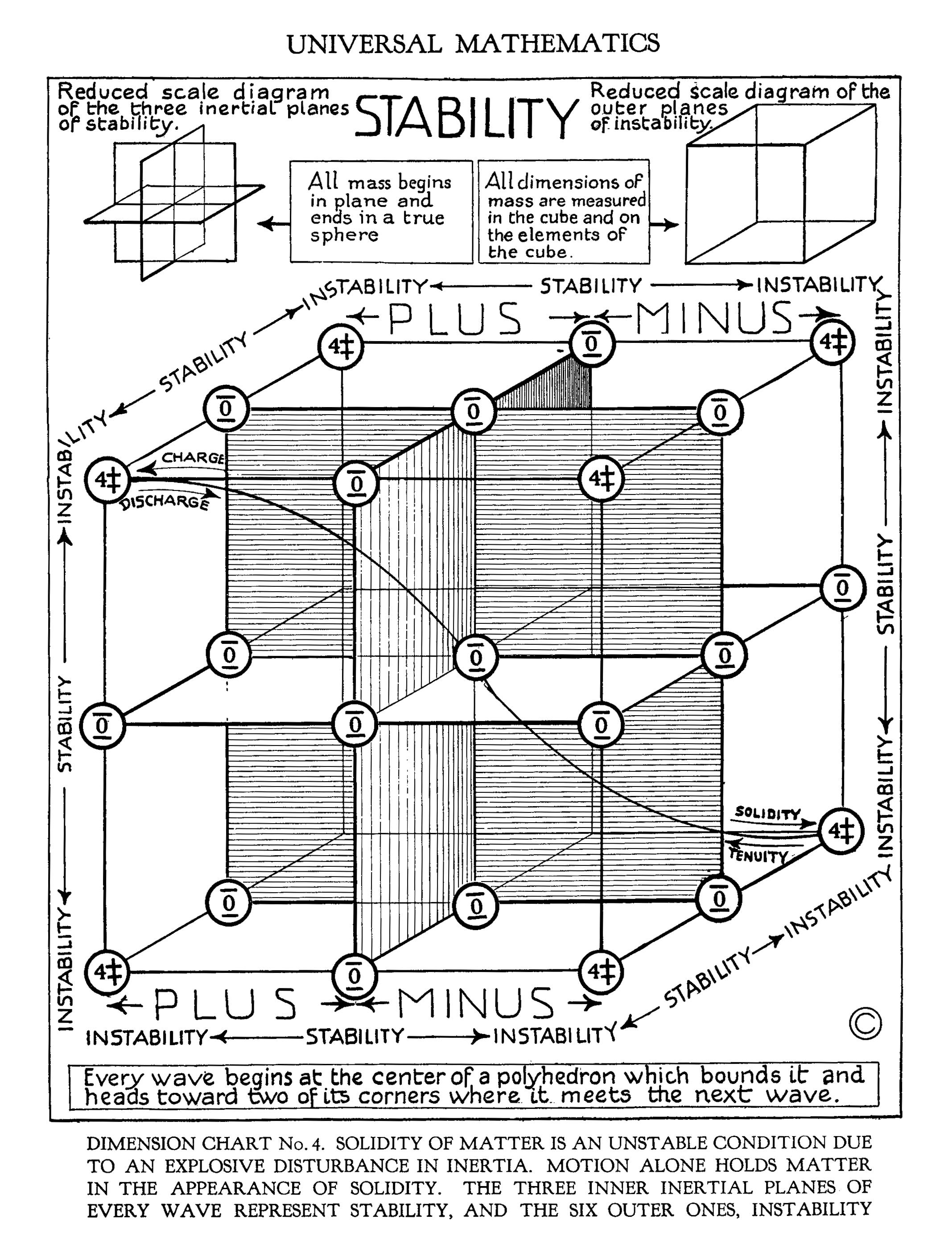
|
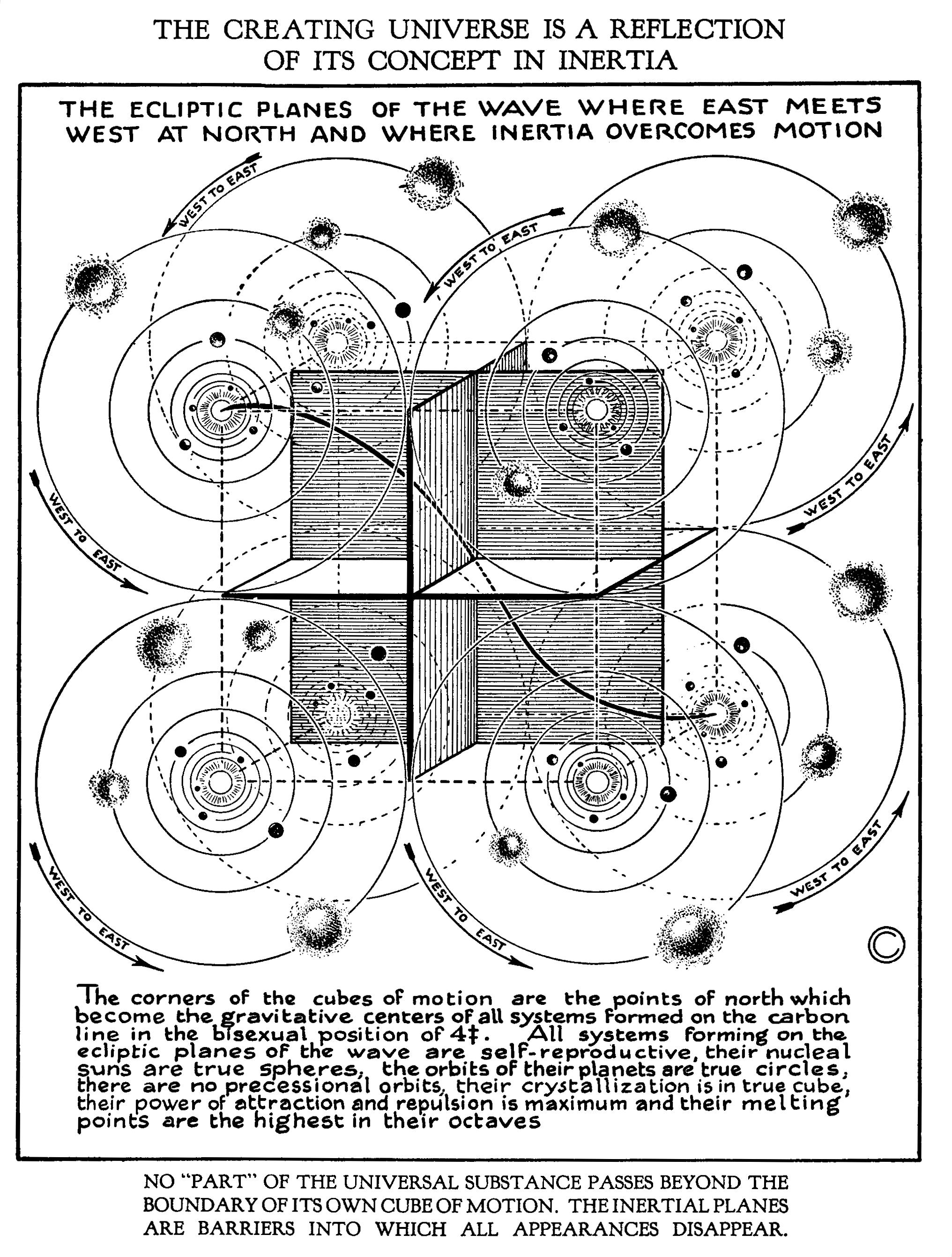
|
Figure 6.10a - Cube structure and Potentials. Figure 6.10b - Cube Dynamics showing Triple Planes of Inertia (courtesy of University of Science and Philosophy)
These Planes of Inertia are the boundaries between dynamical centers of 4++. They appear to be interior planes but only when considering a multitude of cubes as shown in the next section on Compound Cubes (crystals). The three interior planes as shown in the upper right graphic are arranged as Corner Cube Retro-Reflectors. Each corner reflects back to its respective 4++ center.
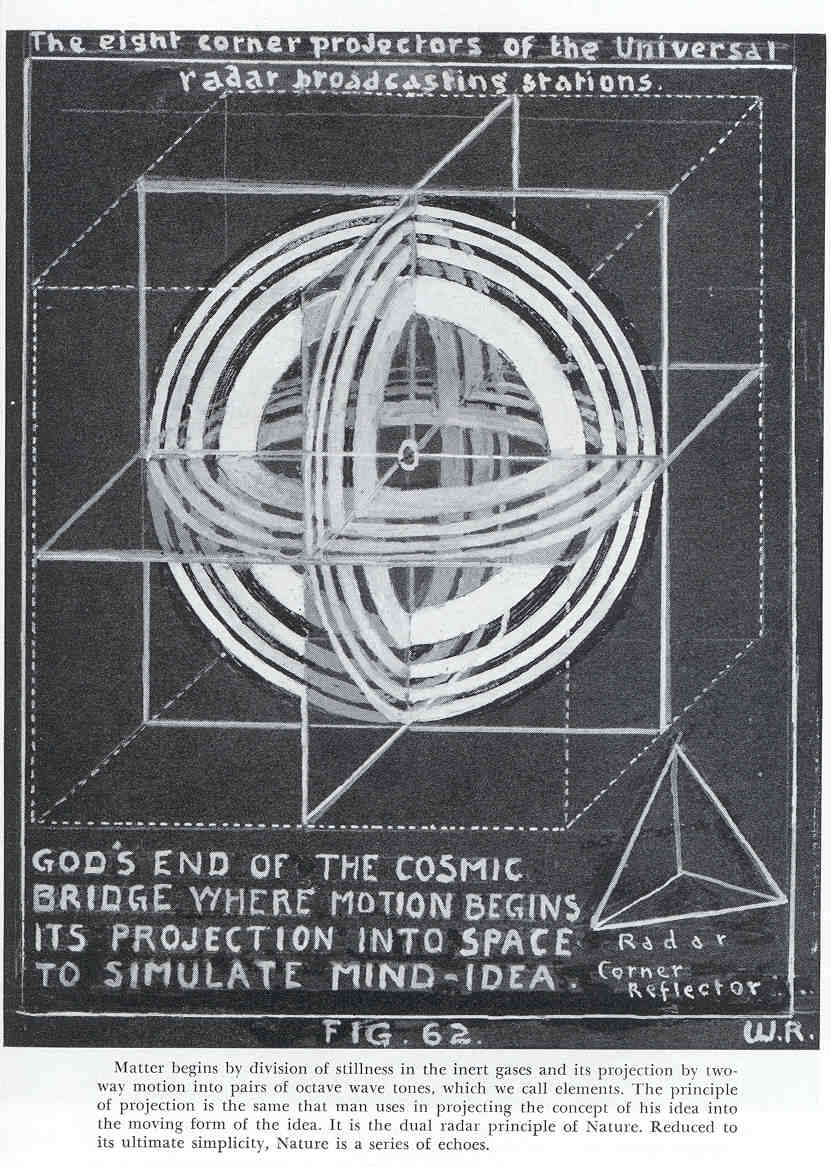
|
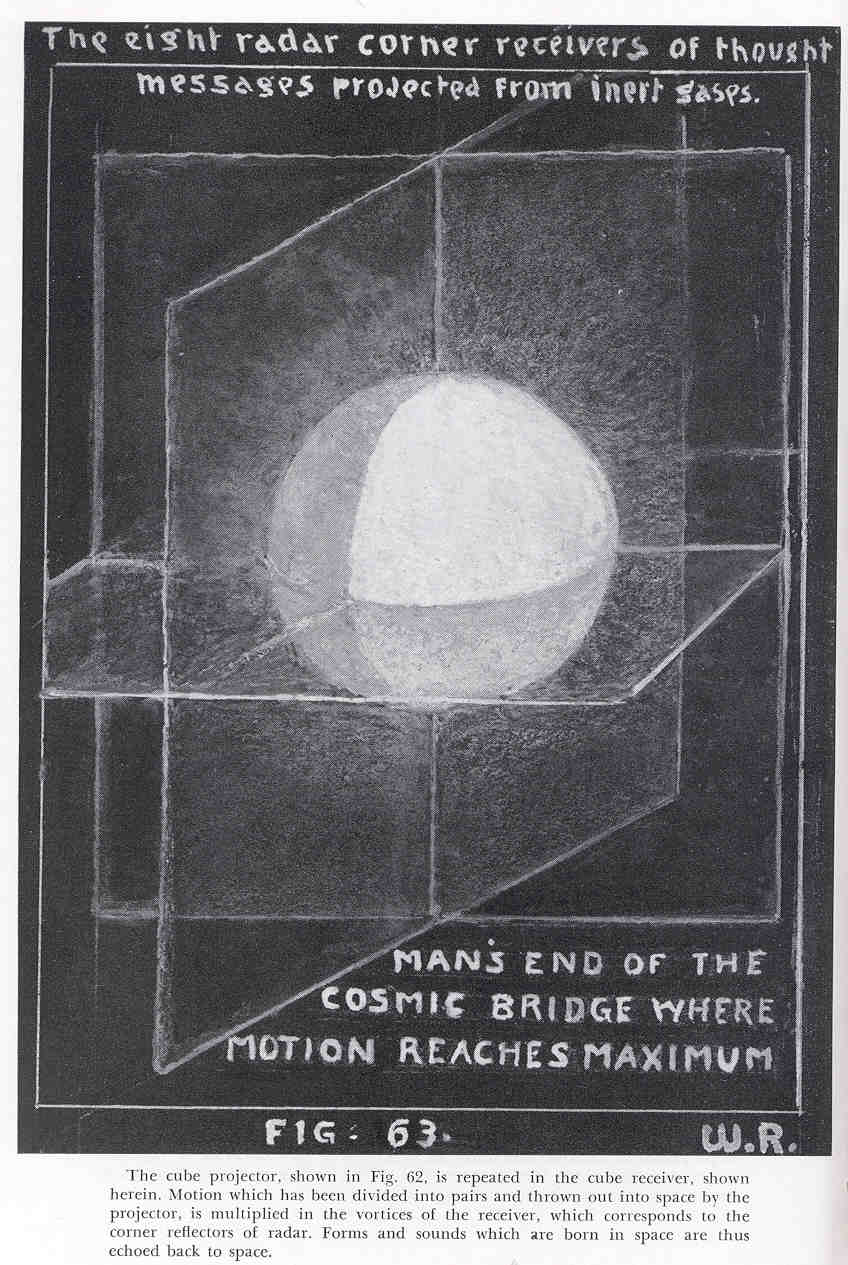
|
Figure 6.11a - Cube Reflectors Dissipating Outward. Figure 6.11b - Corner Reflectors Concentrating Power to Center. (courtesy of University of Science and Philosophy)

Figure 3.26 - Formation of Spheres along Six Vectors of Cubes.
(courtesy University of Science and Philosophy)
(click to enlarge)
Solid Spheres Can Occur Only Where the Six Tetrahedrons of Cubes Unite as One
This drawing shows four of the six tetrahedron lens systems which create, and maintain, gravity-centered spheres. Obviously all six systems are not possible to show on a two-dimensional diagram.
These sexless-systems are bases for countless billions of lens-systems contained within them.
Every microcosmic lens in every macrocosmic lens system focuses its gravity at the same point.
The above rule is true of all of the elements of matter, for all matter is a multiplicity of microcosmic lens-systems, created by wave interchangings, and all focus alike in each element.
Every true sphere is centered by one focal point of gravity. This is true of the hollow cathode spheres as it is of solid anode suns.
The supreme effort of nature is to compress her nine-stratal hollow wave "bubbles" of light into solid incandescent spheres of light, within which the Creator records all forms of mind-idea for unfolding into the light-wave formed images which constitute creation.
Suns are the store-houses of mind-idea. Suns are the seeds of all creation.
Solar systems are the seeds of suns. Through the planets of suns all idea of mind is unfolded into image forms and the drama of creation made possible that is the purpose of suns.
Trough [sic] the light of mind man acquires all knowledge of idea. Through the light of the sun man can acquire unlimite [sic], power to express his idea.
Nature's Method of Compressing Cold Light Waves Into Hot, Gravity-Centered, Spherical Suns.
See Also
Cube Sphere
cube-sphere
Figure 16.02 - Electricity Evolves Mass into Spheres
Figure 2.1.5 - Russells Rings forming Spheres from Three Pairs of Reflecting Mirrors
Figure 3.4 - Focalizing Lenses at nested Cube faces
Figure 4.11 - Six Planes and Three Shafts Coincide to Produce Spheres
Figure 5.4 - Vortex and Gyroscopic Motion on One Plane then on three forming Sphere
Figure 6.12 - Spheres and Cubes are Gods Only Tools
Figure 6.18 - Sphere Circumscribed by Cube
Figure 6.19 - Sphere to Cube - Relations and Proportions
Figure 6.6 - Russells Multiple Views of Tripleness
Figure 7.3 - Step 3 - Sphere Forms Orthogonally Triple Compressing Shell Layers
Gravitational Lens
Gravity
Lens
lense
Mirrors and Lens of Cosmic Cinema
Neutral Center
One More Step Toward Building The Cube-Sphere Wave-Field
pressure lense
Sphere
We Now Build the Nine Equators of Cube-Sphere Wave-Fields
13.09 - Sphere Rotated by Vibrations
19.03 - Philosophy of Transmission and Rotation of Musical Sphere
19.05 - Excerpts from original Articles about Keelys Globe Motor or Musical Sphere
2.1 - Rings and Spheres
20.02 - Keely Describing Dynasphere Construction
5.6 - Vortex Forming Spheres
6.14 - Sphere and Cube
6.5 - Cubes divide into six tetrahedrons
